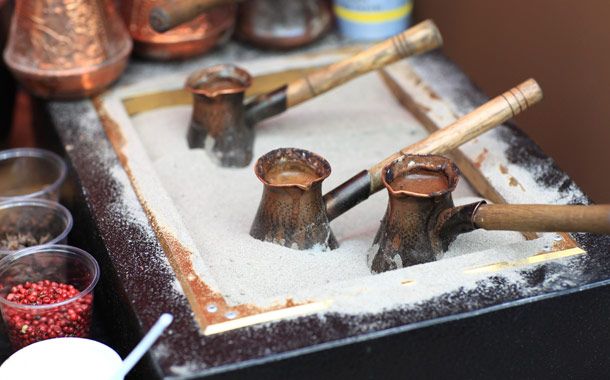Like sherbet in Turkey or tea in England, coffee is an integral part of Greek culture. Even in the tiniest Greek village, you'll see men and women lingering at sidewalk cafes and kafeterias over a small cup of the distinctive Greek blend of coffee. Although Greece is a relatively small country, it ranks as the 15th leading consumer of coffee in the world.
Greek coffee culture
Blame it on the sun and sea or the Greek spirit, ‘going out for a coffee’ in Greece is a serious affair. According to a study Greeks sit down for a coffee and spend an average of 93 minutes before they disperse.
Unlike coffee in other parts of the world, Greek coffee is boiled, not brewed. Traditionally, a briki (a small, brass, lipped pan with a long handle) is used to make Greek coffee. The boiling process creates the distinctive foam atop the coffee, called kaimaki in Greece. Boiling also helps the coffee to retain more of its nutrients and less caffeine than the brewing method does.
Greek coffee is customarily drunk in small, demitasse cups and is consumed throughout the day, not just in the morning. Greek coffee is sipped, not gulped, and it's not unusual for a Greek to drink three to five cups of coffee a day. Patrons in Greek coffee houses are not hurried along. Instead, they are welcomed to visit with friends, read their newspaper and otherwise while away the day.
Types of Greek coffee
Freddo and Freddo cappuccino - Freddo is a double Espresso shaken with ice and served with a straw and crushed ice and the Cappuccino Freddo is the same but topped with a dash of cream.
Greek style frappe. An alternative to traditional Greek coffee, the frappe was accidentally invented in 1957. A popular drink in the summer months, Greek –style Frappe is made by mixing instant coffee, sugar and water in a shaker until a thick frothy layer is formed. The coffee is served in a tall glass topped with ice and evaporated milk.
Freddocino. Freddocino is another cold coffee drink. Made by blending sugar, instant coffee powder and sugar in a slushy machine, Freddocino was introduced in Greece in the 1990s and now accounts for up to one-third of Greek coffee sales.
Greek coffee lore
If you're heading to Greece this season, make sure to stop to savour a cup or two of Greek coffee at a curb-side or seaside cafe. You might even want to bring home a pound of beans or a briki to help you remember your trip.
Find out more about how you can experience Greece
By Sajda Latif
